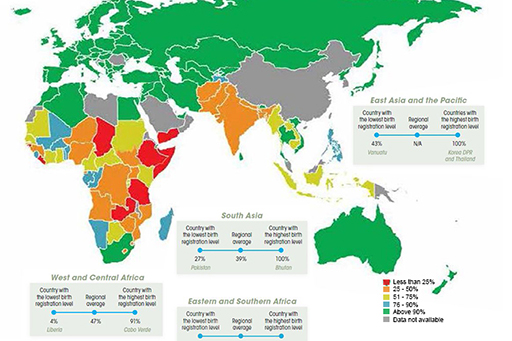1.3 230 million invisible children
It is difficult to overemphasise the importance of birth registration as UNICEF made clear in the video in the previous section. It is the gateway to each child’s rights. Figure 3 illustrates the wide variation in birth registrations around the world.
Children’s rights, as named in the United Nations Convention on the Rights of the Child (referred to below), are essential to protect and provide for children and to ensure their rights to participation. Building on children’s rights to protection, provision and participation has to be a vital element when seeking to address the lottery of birth.
Read an extract from the UNICEF report ‘Every child’s birth right: inequalities and trends in birth registration’ below.
Extract _unit4.2.1
Birth registration, the official recording of a child’s birth by the government, establishes the existence of the child under law and provides the foundation for safeguarding many of the child’s civil, political, economic, social and cultural rights. Article 7 of the Convention on the Rights of the Child specifies that every child has the right to be registered at birth without any discrimination.
Nevertheless, the births of nearly 230 million children under the age of five worldwide have never been officially recorded. Asia is home to more than half of these children.
Apart from being the first legal acknowledgement of a child’s existence, birth registration is central to ensuring that children are counted and have access to basic services such as health, social security and education. Knowing the age of a child is central to protecting them from child labour, being arrested and treated as adults in the justice system, forcible conscription in armed forces, child marriage, trafficking and sexual exploitation. A birth certificate as proof of birth can support the traceability of unaccompanied and separated children and promote safe migration. In effect, birth registration is their ‘passport to protection.’ Despite the importance of obtaining official and documented proof of registration, around 290 million children (or 45 per cent of all children under age five worldwide), do not possess a birth certificate. Universal birth registration is one of the most powerful instruments to ensuring equity over a broad scope of services and interventions for children.
Unicef have provided a review of the sustainable development goals from a child rights perspective, ‘A post-2015 World Fit for Children’. The child right’s perspective is key to addressing the lottery of birth. Read an extract from the review below.
Extract _unit4.2.2
Never before has there been an articulation of all aspects of sustainable development – the social, the economic and the environmental – together in one place.
Crucial issues for children have been captured across the goals and targets: the strengths of the MDGs have been enhanced, and several areas where the MDGs were silent – including reducing inequality, ending violence against children and combating child poverty – are now recognized and addressed. Right from the introductory text, children youth and future generations are referenced as central to sustainable development.
This year, as we celebrate the 25th anniversary of the Convention on the Rights of the Child (CRC), the review examines the critical goals and targets for children proposed by the OWG [Open Working Group] that must be maintained in the final SDGs and highlights areas that could be further reinforced.
As important as the goals, targets and indicators themselves is the world’s shared vision of the future we want. It is a world that is safer and cleaner, where all people live free from fear and want, where all people are healthy, well-educated and treated equally and with dignity. It is a world where they have hope. The fundamental building block for achieving that future is an investment in the rights of all children, in every place in the world – regardless of the child’s gender, ethnicity, race, economic, disability or other status. If we do not make this investment, the future will not only be unsustainable, it will be bleak. When a child is not healthy, is chronically malnourished, does not receive a quality education, does not feel safe in his or her home, school or community, or lacks the opportunity to have his or her voice heard, this child will not be best equipped to fulfil his or her full potential. That not only denies the individual child his or her rights, but also deprives the entire human family of the intellectual, social, moral and economic benefits that derive from the fulfilment of these rights. The future will be filled with both great opportunities and immense challenges. Children must be able to harness those opportunities and face those challenges. At the heart of these goals are future generations – today’s and tomorrow’s children.
In the next section, you will shift your focus to find out more about a particular element of the Sustainable Development Goal that focuses on climate change, believed by many to be the most worrying part of growing up in the early 21st century.

